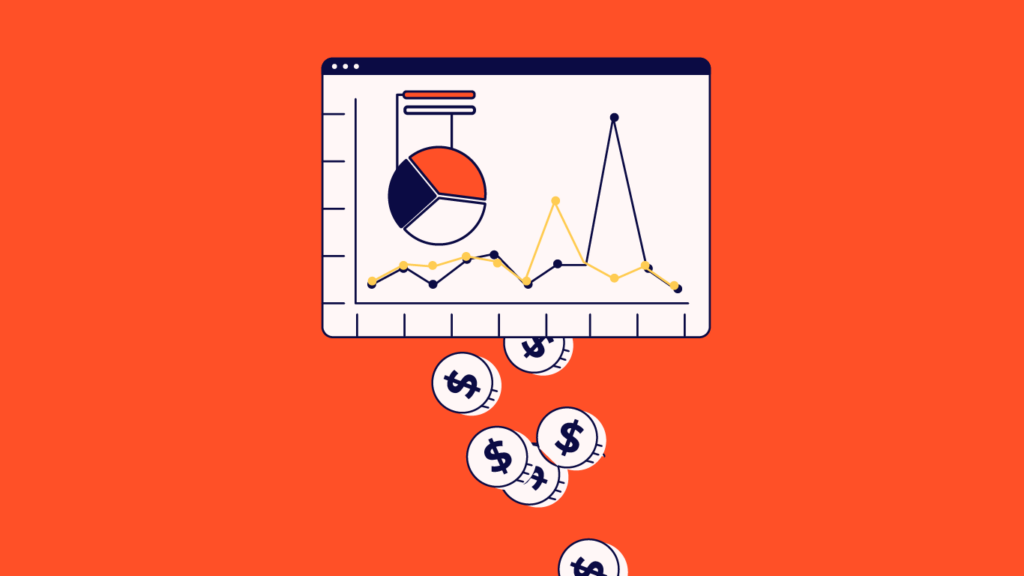In 2019 alone, nearly two billion people purchased products or services online. During that same period, ecommerce sales reached approximately $3.5 trillion worldwide.
And that was 2019.
If you look at the growth of worldwide retail ecommerce sales from 2014 to 2023, there’s every reason to believe that this trend will continue.
As an ecommerce store owner or marketing professional, this data is encouraging. There’s a big opportunity to make your mark.
But there’s also something else to consider: increased competition from retailers.
With brands big and small (and everywhere in between) spending more time and money establishing a strong ecommerce presence, you must be prepared for anything and everything that comes your way.
And that’s why you should get into the habit of tracking all the most important ecommerce key performance indicators (KPIs).
There’s a lot to learn before we examine the most important metrics and ecommerce KPIs, such as: what is a KPI, the 5 types of KPIs, and why ecommerce KPIs are critical to the success of your business.
What is a KPI?
Before we get into the finer details, let’s define KPI:
A key performance indicator is a measurable value that demonstrates progress toward an intended result.
These are used to accurately show whether a business is moving toward its goal, falling behind, or remaining stagnant.
The 5 Types of KPIs
The more you learn about KPIs, the more you’ll realize that they span every imaginable business operation.
Some KPIs are quantitative, others are qualitative, and there are those that focus on the past or predict what’s to come.
Generally speaking, there are five distinct types of KPIs, including:
- Sales
- Marketing
- Project management
- Customer service
- Manufacturing
Your brand and the way your business is structured will determine which of these types you track.
For example, every ecommerce brand can benefit from tracking sales and digital marketing KPIs.
However, if you don’t personally manufacture a product - but instead dropship, for instance - KPIs within this category may not require much of your attention.
Why are Ecommerce KPIs Important to Your Business?
Money, money, money. That’s what it’s all about, right?
While sales are important, there’s more to it than what you see on the surface. It’s imperative to dig deep to better understand what’s driving sales, where you’re missing out, and the changes you can make to take your online store to new heights.
There are many reasons why ecommerce KPIs are important to your business, including but not limited to:
- KPIs help you better understand your business
- KPIs help you better understand your customers and target audience
- KPIs allow you to track performance (and provide your team with guidance)
- KPIs can save you time and money over the long run
No two brands take the exact same approach to tracking ecommerce KPIs and using the data to boost performance, but every brand can benefit from doing so.
Erin Schurtz, VP of Marketing at FreshLime, shared her thoughts on why ecommerce KPIs are essential to long-term success:
“A lot of the companies we work with focus the majority of their attention on data related solely to sales. They want to know how many sales they made on a specific day and the amount of money that was generated as a result. But what they’re missing out on is the behind the scenes KPIs. Things like conversion rate and shopping cart abandonment rate. It’s important to remember that these are the things that drive your bottom line.”
With all this in mind, it’s time to turn our attention to the ecommerce KPIs (in no particular order) you can’t afford to ignore. These are the ones that have the biggest impact on your business.
1. Website Traffic
Website traffic is the lifeblood of your ecommerce business. Without this, no one will see your products. And without eyeballs, there’s no chance of making a sale.
“I tell all my ecommerce clients the same thing: site traffic from organic search isn’t the only KPI that matters, but you need to understand it in order to move onto everything else,” said Charlie Rose, President of SEO Mechanic. “Once you have an idea of your current level of traffic, you can set realistic short and long-term goals. You can also use this data to calculate and track other KPIs, such as conversion rate.”
Overall, site traffic is its own statistic. This refers to the total number of visits your ecommerce site receives. However, there is corollary data that’s just important, such as:
- Page views: the total number of page views.
- Pages per session: the number of pages a person visits before leaving your website:
- Average session duration: the average amount of time a visitor stays on your website.
For example, it’s one thing to know how many people have visited your online store during a specific period of time. But it’s another thing entirely to know the pages they visited and how long they were on your ecommerce website.
With this information, you can answer questions such as:
- Which category and product pages are most popular?
- Is your website holding the attention of your audience?
Don’t do anything else regarding KPIs until you have a clear system for tracking and analyzing site traffic.
2. Conversion Rate
You can drive millions of people to your online store every month, but if they don’t convert into buyers you’ll end up with nothing but disappointment.
Your site’s conversion rate, displayed as a percentage, is the rate at which visitors make a purchase. It’s calculated by dividing the total number of purchases by the total number of visitors.
For example, if 2,500 people visited your online store and 100 of them made a purchase, your conversion rate is four percent.
In addition to calculating conversion rate for overall site traffic, drill down by focusing on:
- Conversion rate by product
- Conversion rate by product category
Also, when tracking this KPI for growth, you can compare it to industry standards.
According to Smart Insights, the overall online retail average is three percent. However, this varies by sector.
If your conversion rate is higher than what you see here, you’re on the right track. If its lagging behind the industry average, you have some work to do.
Remember this: you don’t need more traffic to make more sales and generate more revenue. You simply need a higher conversion rate.
3. Shopping Cart Abandonment Rate
Out of all the ecommerce KPIs, this one has the potential to cause the most frustration.
There’s nothing worse than finding out that consumers are adding products to their online shopping cart, just to leave your store before completing their purchase.
With this KPI, lower is always better. This means that fewer people are leaving your store with at least one item in their shopping cart.
If you’re experiencing a high cart abandonment rate, it likely means that there’s too much happening during the checkout process.
Maybe you’re forcing the buyer to create an account. Maybe it’s too confusing to provide payment information.
Regardless of the cause, you must get to the bottom of it.
According to Baymard Institute, the average documented online shopping cart abandonment rate is 69.57 percent (this fluctuates).
Imagine that: on average, most brands experience a nearly 70 percent abandonment rate. That means that seven out of 10 buyers are leaving items in their cart.
How much revenue would it generate if you cut that number in half? What about if you shaved off even 10 or 15 percent?
Once you calculate this number, you’ll no longer wonder why it’s so important to track this ecommerce KPI.
4. Customer Acquisition Cost
Also known as CAC, customer acquisition cost tells you how much your company spends to acquire a new customer.
Just the same as cart abandonment rate, you want this number to be as low as possible. The lower the number, the more money you earn when someone makes a sale.
Calculating customer acquisition cost starts with tracking your overall advertising and marketing spend. For example, this could include paid ads (PPC), social media marketing, and content marketing.
Once you know how much you’ve spent over a specific period of time, such as one week or one month, tally the total number of customers generated during that time.
Tip: implement a system for tracking sales that derive from your advertising and marketing efforts. This allows you to accurately calculate your customer acquisition cost, instead of simply being in the ballpark.
There are many places you can turn to help with this, such as your Google Analytics account. This video walks you through how to set up goals:
[youtube https://www.youtube.com/watch?v=2Ke3-0Jsl-I&w=560&h=315]
Once you know your average customer acquisition cost, it’s easy to see how it stacks up to your average order value (AOV).
When your average order value is higher than your average customer acquisition cost, you’re usually making money on every transaction. If it’s not, you’re losing money.
CAC isn’t something you can ignore.
5. Average Order Value
Some people call it average order value. Others call it average order size or average market basket.
Regardless of the name, its purpose remains the same: to show you how much money a customer typically spends on an order.
This goes hand in hand with customer acquisition cost (see above).
You may get excited to find that you have a high average order value for your industry, until you realize that your CAC is higher than this. This means you’re probably losing money.
Calculating the average order value is simple. You need two things:
- The number of sales generated in a specific period
- The revenue generated by those sales
You can then divide the revenue generated by the number of sales.
Example: $100,000 in sales / 400 sales
With these numbers, the average order value works out to $250.
Now, take this number and compare it to your CAC. If it’s higher, you’re making money on every purchase.
There’s no benchmark as to what is and isn’t a good average order value. It depends on a variety of factors, including browsing device, location, and industry.
According to Statista, the average value of online shipping orders in the United States varies greatly by device:
6. Customer Lifetime Value
Customer lifetime value, also known as CLV, shows you how much a customer is worth over the entire course of their relationship with your business.
As a general rule of thumb, you want this number to increase as you grow your brand’s authority and forge better relationships with your past customers and prospects.
There’s more than one way to calculate customer lifetime value, but here’s one of the best:
There’s nothing wrong with strategizing to generate new customers, but don’t get so caught up in this that you neglect those who have purchased from you in the past (more on this below).
A high customer lifetime value means more revenue over the long run. It also means you’re doing something right in regards to how you connect with your audience.
7. Customer Satisfaction Score
Let’s switch gears a bit and focus on customer satisfaction.
There are many reasons why customer satisfaction score (CSAT) is an important KPI, including the fact that it has a direct effect on customer lifetime value and returning customer orders.
Assaf Parag, Founder and CEO of Opinion Stage, shared his thoughts on the importance of this KPI:
“At Opinion Stage, many of our customers are interested in using surveys to collect satisfaction feedback from their buyers. One thing they all have in common is a basic understanding of why this is so important to their business. Unfortunately, the ones that seem to find us the most are the ones who realize that their customer satisfaction score has dropped off.”
Unlike KPIs in other categories, such as sales and marketing, those pertaining to customer satisfaction are more difficult to measure. That’s because you’re reliant on your customers to provide feedback.
You won’t get everyone to participate, but the more people who share information the easier it becomes to determine if you have a problem in this area. Find out how having a CRM system can help boost your performance when it comes to customer relationships here: 16 Stats That Prove The Benefits Of Ecommerce CRMs.
8. Email Open Rate
Email marketing is not dead. Let me repeat: IT’S NOT DEAD!
Check out these statistics from HubSpot:
Now what do you think? Should you give email marketing a try? Should it remain a big part of your marketing strategy?
It’s not good enough to send regular emails to your list. You need to know what’s working, what isn’t, and how you can tweak your messages in the future for a better response.
While there are many statistics related to your email marketing efforts, open rate is among the most important.
This is similar to site traffic in the way that you can’t get any benefit from email marketing unless people see what you have to say.
Once you begin to track this KPI — which is simple through your email marketing provider — compare your results to this chart:
The average email open rate in the ecommerce industry is 15.68 percent. If you can best this, you’re on the right track.
9. Time on Site (and Bounce Rate)
Way back at the beginning of this article we talked about site traffic. But we didn’t dive too deep into these details:
- Average time spent on site (average session duration): the amount of time, on average, that a visitor stays on your site.
- Bounce rate: the percentage of visitors who leave your site before visiting another page.
The more time someone spends on your site, the better chance there is that they’ll make a purchase.
For example, if your average time on site is only 10 seconds, that’s a problem. That’s not enough time for someone to shop, review their cart, and checkout.
Bounce rate is an engagement metric. It’s the percentage of single page visitors to your site.
So, if you have a high bounce rate and most people land on your home page, they never see the products that are available or the guidance you provide.
Track both of these KPIs carefully, making note of problem areas that require your attention.
10. New Customer Orders vs. Returning Customer Orders
Do you remember above when we talked about customer lifetime value?
This KPI is closely related. It measures the number of new (first time) orders vs. returning customer orders.
The primary benefit is the ability to answer these two questions:
- Are you focusing too many resources on customer acquisition and not enough on customer retention?
- Is there a reason why people aren’t buying from your brand more than once?
New customer acquisition is important, but try to strike a balance with returning customer orders. Track the number of orders for each type.
When you build your brand, you build customer loyalty. And when you build loyalty, you have a strong base of customers who will purchase from you into the future.
Final Thoughts on Ecommerce KPIs and Metrics
Are these the only ecommerce KPIs you should track?
Maybe, maybe not. But one thing is for sure: these 10 should definitely be part of your overall strategy.
It may not be something you’ve focused on in the past, but ignoring KPIs in the future could stop your brand from reaching its full potential. And that’s not a risk you want to take.
So, no matter how you do it, make sure you track these 10 ecommerce KPIs at a minimum. You won’t regret your decision!


